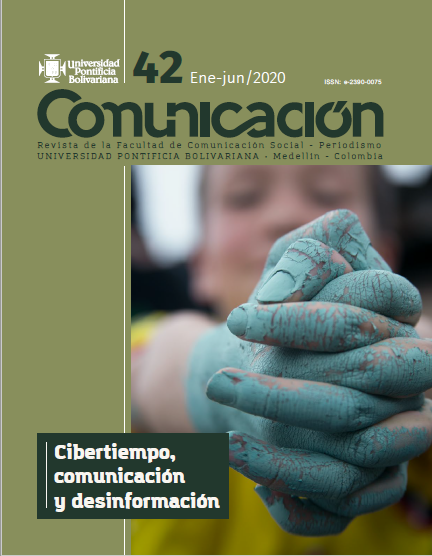Metaphors and the public image of the sciences
Main Article Content
Abstract
Public Communication of Science and Technology plays a relevant role in today’s ‘Societies of Knowledge’ not only in the dissemination of theories and innovations but also because it contributes to shape a scientific culture (López Cerezo, 2005). For this reason, it is of interest for the studies on Communication as well as for the studies on Sociology and Philosophy of Sciences. In this field, we focus on the use of metaphors and their cognitive reach. Our hypothesis is that metaphor is not merely an instrument for didactic or communicational purposes, but it has the capacity to produce new meanings and to reinforce existing meanings in the wider cultural frame.
In this paper, we shall focus on the metaphors the digital press habitually uses to refer to the sciences. These metaphors contribute to the consolidation of a public image of the sciences, of scientists and of their activity. Based on recent theories on metaphors and the communication of sciences (Lizcano, 2009; Palma, 2012), we put forward an analysis of news and editorials that recur to metaphors such as “impact”, “struggle”, and “endeavor”. We also make some reflections on the meanings they produce, the image or science they produce and the resulting image of science.
We shall argue that these metaphors are more frequent than would be expected. Also, they produce an image that ponders sciences as a privileged form of knowledge and promotes a kind of relationship in which society lacks the relevance required by a critical scientific culture.
References
Antonio, F. M. (2004). El discurso periodístico a través de la lingüística textual. Opción, 20(43), pp. 77-100.
Belucci, M. (2018). Entrevista a Gabriela González. La teoría de la relatividad de Einstein es incompleta, está quebrada. Clarín, 29 de julio de 2018. Disponible en: https://www.clarin. com/sociedad/teoria-relatividad-einstein-incompleta- quebrada_0_HJYUlRoNX.html.
Black, M. (1966). Modelos y metáforas. Madrid: Tecnos.
Ciapuscio, G. (2011). De metáforas durmientes, endurecidas y nómades: un enfoque lingüístico de las metáforas en la Comunicación de la ciencia. ARBOR Ciencia, Pensamiento y Cultura, 187-747, pp. 89-98.
Cortassa, C. (2010a). Asimetrías e interacciones. Un marco epistemológico y conceptual para la investigación de la comunicación pública de la ciencia. ArtefaCToS. Revista de estudios sobre la ciencia y la tecnología, 3(1), pp. 151-185.
Cortassa, C. (2010b). Del déficit al diálogo, ¿y después? CTS: Revista iberoamericana de ciencia, tecnología y sociedad, 5(15), pp. 159-184.
Derrida, J. (1992 [1989]). Force of Law: The ‘Mystical Foundation of Authority’. En: Drucilla Cornell, Michael Rosenfield and David G. Carlson (eds.), Deconstruction and the Possibility of Justice (pp.3-67). New York: Routledge.
Derrida, J. (1992 [1989]). Force of law: Mystical foundation of Authority en Deconstruction and the Possibility of Justice. Routledge.
Espinoza, P. (2012). Comunicación y conflicto: metáforas. Conexión, (1), pp. 123-137.
Gelbes, S. (2018). El discurso híbrido. Formas de escribir en la web. Buenos Aires: Ed. Ampersand. Disponible en: https://www.edicionesampersand.com/product-page/eldiscurso-h%C3%ADbrido.
Golombek, D. (2010). Meter la ciencia de contrabando, tarea del divulgador: Diego Golombek. Entrevista de Adrián Estrada Corona. Revista Digital Universitaria. Disponible en: http://www.revista.unam.mx/vol.11/num12/art111/index.html.
Lakoff, G. & Johnson, M. (2004 [1980]). Metáforas de la vida cotidiana. Madrid: Cátedra.
Lizcano, E. (2009). Metáforas que nos piensan. Sobre ciencia, democracia y otras poderosas ficciones. Buenos Aires: Biblos.
López Cerezo, J. A. (2005). Cultura científica y participación formativa. Arbor, 181(715), pp. 351-362.
López Cerezo, J. A. & Luján, J. L. (2004). Cultura científica y participación formativa. En: I. Fuentes Julián y S. Casado de Otaola (coords.), Percepción social de la ciencia (pp. 29- 45). España: Ediciones de la Academia Europea de Artes y Ciencias de España.
López Gil, K. S. (2016). Prácticas de lectura digital de estudiantes universitarios. Enseñanza & Teaching, 34(1-2016), pp. 57- 2. Disponible en: http://revistas.usal.es/index.php/0212- 5374/article/view/et20163415792/15210.
Mapelli, G. (2004). Estrategias lingüístico-discursivas de la divulgación científica. Actas XXII, AISPI. Centro Virtual Cervantes. Disponible en: ttp://cvc.cervantes.es/literatura/aispi/ pdf/20/II_12.pdf.
Olivé, L. (2013). La ciencia y la tecnología en la sociedad del conocimiento. Ética, política y epistemología. México: FCE.
Palma, H. (2015). Ciencia y metáforas. Crítica de una razón incestuosa. Buenos Aires: Prometeo.
Rossini Favretti, R.; Tamburini F. & De Santis, C. (2002). CORIS/CODIS: A corpus of written Italian based on a defined and a dynamic model. R. CILTA - University of Bologna - Italy. Disponible en: https://www.researchgate.net/publication/2899217_CORISCODIS_A_ corpus_of_written_Italian_based_on_a_defined_and_a_dynamic_model.
Seghiri, M. (2011). Metodología protocolizada de compilación de un corpus de seguros de viajes: aspectos de diseño y representatividad. Rla. Revista de lingüística teórica y aplicada, 49(2), pp. 13-30. https://dx.doi.org/10.4067/S0718- 48832011000200002
Vacarezza, L. (2009). Estudios de cultura científica en América Latina. Redes, 15(30), pp. 75-103. Disponible en: http://www.unq.edu.ar/advf/documentos/58c2fbf16a174.pdf.





